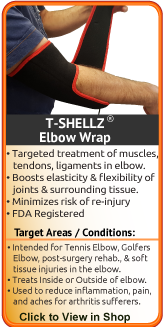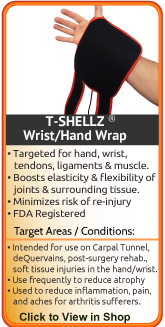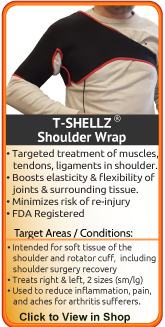Golfers Elbow
(Medial Epicondylitis)
Your elbow seems to function in quite a straightforward manner, yet within this seemingly simple joint many complexities exist. The importance of the elbow becomes even more prevalent when looking at is as a key contributor to the overall use of our whole arm and shoulder. It is a complex system of bones, muscles, nerves and tendons. The elbow joint gives us the ability to lift with strength, climb trees, build a house or something as simple as hold your cellphone to your ear. It is so unique that the joint allows the muscles in the forearm to rotate when we twist our wrist. The tissue is ropy and strong, yet delicate at the same time.
You might be suffering from a golfers elbow if:
- You have sharp pain on the inner side of your elbow.
- You have swelling and tenderness on the inner side of your elbow, especially after doing any activity.
- You feel weakness in your elbow.
- You're suffering from pain on the inner part of your elbow with activities like picking up objects with your palm down, flexing your wrist and fingers forward or rest your forearms on a surface.
If you are experiencing any of the above symptoms or you are suffering from on-going pain on the inner part of your elbow then you may be experiencing a golfer's elbow injury.
What is Golfer's Elbow?
It is a form of chronic degeneration of the tendon called tendinosis. There won't be much swelling but significant tenderness on and around the tendons that attach to the small bony part on the inside of your elbow (medial epicondyle).
What causes Golfers Elbow?
Golfers Elbow is commonly caused from the overuse of the tendons and muscles located in your forearm (brachialis, brachioradialis, pronator teres and flexor carpi radialis). The group of muscle and tendons in your arm and elbow help to close (pronate) your wrist and fingers. The wear and tear on these tendons is a result of small tears in your tissue that don't heal properly.
Anyone can suffer from golfers elbow - a job that has you using your hands, wrists and fingers doing a repetitive action will put quite a bit of the stress on these tissues over time. Jobs may include: mechanic, lab technicians, hygienists, plaster, painter, pitcher, gardener or carpenter. Sporting activities include; video games, baseball, tennis, racketball and bowling.
Golfer's Elbow is most often a result of forceful contractions and overuse, such as pushing down while using a screwdriver. Vigorous use and movements or overstraining of the forearm muscles that move your fingers, hand, wrist and forearm. The tendons and muscles are pushed and pulled with such forces that tiny tears form in the tissue and scar tissue and/or calcium deposits form. The growth of scar tissue will put pressure on your soft tissue and nerves, and interrupt the blood flow to this area; this can be very painful
If golfers elbow pain is due to a deterioration of the tendon (tendinopathy), it can take from two to six months to fully recover. Many cases of golfers elbow become chronic problems that progressively get worse if the sufferer continues performing the causal activity that started the condition in the first place. When you do this, your body telling you there is a problem as the area will continue to generate a lot of pain.

Chronic Golfers Elbow: Tendinosis will get worse over time if not dealt with correctly or quickly. The inability to heal the tendinosis will cause it to keep coming back or last months or even years. The main long-term problem associated with golfers elbow is failed healing, not inflammation. If you cannot rest the elbow from the activity that started it in the first place, then you will have little to no chance of healing this chronic injury. Eventually you risk the event of a complete tendon rupture which would only be fixable through reattachment surgery (and possible debridement and grafting).
Acute elbow tendonitis: An acute injury may be caused from a weekend re-roofing your house or putting in a new flowerbed. Most times we push our bodies too much too soon before properly warming-up that area. Repetitive use of the elbow over time causes small tears in the tissue with not enough time to heal in between (degenerative) - a good example of this is achilles tendonitis in runners - the achilles in runners is damaged during runs without adequate time to repair before incurring more damage.
Do You Really have Golfers Elbow?
Visiting your doctor when you have elbow pain is always recommended, as there are many possible issues that can happen within the arm and elbow. Sometimes, one set of symptoms can result in multiple diagnoses.
Infection (Septic Bursitis). The closer the bursa is to the surface of the skin, the more likely the chance of infection from specific bacteria that are commonly found on the surface of the skin. This bacterial infection is known as septic bursitis and it is caused by the Staphylococcus Epidermis (or Staphylococcus Aureus) bacteria. Septic Bursitis occurs most commonly in men (85% of all cases occur in men) and you are at higher risk of contracting this if you - have Diabetes
- have recently experienced trauma
- are undergoing steroid treatments
- have a certain kidney condition
Warning: Septic Bursitis is a Dangerous Condition that can quickly become life threatening. This is one reason why you should always get to a doctor to find out what the real problem is. If you have not been diagnosed, then get to a doctor if you have not ruled out this condition!
Crystal Deposits. Some people with diseases such as rheumatoid arthritis, gout or scleroderma may contract bursitis from crystalline deposits in the joints. Although not much is known about how this process happens, it is common knowledge that Uric acid is a normal byproduct of daily metabolism. If your are diagnosed with gout then you are unable to break down this uric acid properly, leading to crystallization of this excess acid which deposits in joints, a painful symptom that can often lead to bursitis.
Tennis Elbow Tendonitis. (lateral epicondylitis). Pain will be felt around the bony , outside part of the elbow. With golfer's elbow, pain will be felt on the inside of the elbow. The tendons attached to the bone at your elbow are connected to muscles in your forearm, which is why these injuries will sometimes cause pain in your forearm. These injuries are usually caused by racquet sports, golf and overuse from gardening and repetitive movements of your hand or wrist (ie. using a screwdriver).
What are the Symptoms of Golfer's Elbow?
As stated earlier, symptoms of golfer's elbow include:
- You have sharp pain on the inner side of your elbow, repetitive movements such as holding, squeezing, twisting with your hands or wrists, or curving your fingers.
- You have swelling and tenderness on the inner side of your elbow, especially after doing any activity.
- You pain that starts on and around the bump on the inside of your elbow, and will eventually radiate from the inside of your elbow down to your forearm and wrists.
- You feel weakness in your elbow.
- You're suffering from pain on the inner part of your elbow with activities like picking up objects with your palm down, flexing your wrist and fingers forward or rest your forearms on a surface.
In the beginning (before the injury becomes chronic), this pain will often go away within 24 hours after an activity. However if not dealt with immediately, your pain and stiffness will get worse over weeks or months, to the point where you may feel soreness even when your arm is still. You can also experience a severe burning pain and atrophied forearm muscles (loss of muscle mass), which results in a weakened grip. If left untreated, you may experience extreme loss of motion and function of your elbow and forearm.
How Do I Diagnose Golfer's Elbow?
The best way to diagnose this condition is with a quick visit to the your doctor for a physical examination of your elbow, arm and wrist. The doctor will be looking for tenderness on the inside of your arm.
Range of motion movements / tests, will be done to see how much movement has been lost in the elbow and arm. Your elbow might hurt from the doctor poking and prodding at it, but by doing this the doctor will know for sure the source of your pain, the level of tenderness in and around your elbow and how well your elbow can move with this condition.
Your doctor may also consider any previous elbow injuries or joint stiffness that you may have had in the past. This will help the doctor to determine if you have a more complex injury in your elbow and rule out any other elbow injuries that may be present.
An x-ray of the elbow will provide clarification if you are suffering from a bone related condition such as arthritis, gout or a fracture to any bone in your elbow.
Other tests like a bone scan, MRI (magnetic resonance imaging) or blood tests may be done if an x-ray looks normal or the doctor is unsure whether you have a fracture. These tests will also rule out any infections of the bone or tissue.
Tendinosis: What is it?
Tendonitis is a non-inflammatory, degenerative condition of the tissue (collagen fibers) in the tendon often caused by repetitive stress injury of the tendon fibers. As the collagen breaks down the typically straight and flexible fibers become a tangled mess with little pockets of jelly.
Tendonitis is caused by repetitive motion which causes an accumulation of micro injuries. The tendon tries to repair itself but eventually the breakdown of the collagen fibers exceeds the repair and the new collagen is produced with an abnormal structure and composition.
Unlike tendonitis, there are no inflammatory cells with a tendonitis injury making it hard to diagnose visually as there are no visible symptoms such as swelling, heat and redness. However, both injuries cause pain, tenderness and stiffness of the joints.
If not treated correctly the tendon will continue to degenerate causing further injury.
How Do I Get Rid of Golfer's Elbow?
The good news is that most cases of golfer's elbow will heal with simple home conservative treatments and surgery is often not needed. It's generally understood by doctors and surgeons, that surgery will introduce more scar tissue into the elbow. This added scar tissue will be problematic, requiring visits to the Physio clinic and conservative treatment options post-surgery. This is why surgery is only performed as a last resort for chronic elbow injuries or a fractured bone that won't heal with conservative treatment methods.
If you have talked with your doctor and have learned that your condition does not require surgery (as is the case with complete tears or serious degeneration), the easiest way to address an acute soft tissue injury is with simple conservative treatments and generally this includes the following:
- Rest - This is important for initial healing to reduce pain, swelling and inflammation in the early stage of your elbow injury. Too much rest can also be harmful to elbow injuries because joint immobility can actually cause stiffening in the elbow (and even shoulder) joint. This is why rest should be used when reducing initial pain and swelling, but should not be considered for more long-term conservative treatment.
- Avoid Activities that Caused Your Injury - While resting your elbow, it's important to avoid activities that may have caused your injury in the first place and this definitely includes pretty much any type of sport where your upper body is involved. Continuing on with regular activities will not only make your injury worse, but trying to 'work around' your injury will eventually give rise to over-compensation injuries in other areas of your body.
- Use a Cold Compress or Ice Pack - Cold is very effective at reducing pain and inflammation - use at the onset of the injury and during flareups.
- Use an Elbow TShellz Wrap® (Circulatory Boost device) - You can use your own blood flow to maximize your rehabilitation, maintain healthy blood flow to your arm and elbow, decrease recovery time, and reduce re-injury risk.. Promoting blood flow to your elbow using a warming treatment will help to minimize the growth of scar tissue and increase flexibility. This is why we recommend TShellz Wrap before undergoing activity - an increase in flexibility should help reduce risk of further injury while also assisting in the battle against atrophy.
- PT - Surgery is usually the last resort. This means doctors or surgeons typically won't perform a surgery until they feel that their patient has put effort into treating their injury with conservative treatment methods. This includes 4 to 6 months of visits to a physical therapist (PT). If you haven't experienced any improvement in your condition during that time then surgery may be considered. Agressive PT approaches will focus on forced or manual manipulation of the elbow and wrist - this means your physical therapists will be trying to move you past the point of comfort as they strive to increase range of motion and prevent further atrophy. This can be painful and end up making your injury worse if not done correctly. (reference: 1)
- Stretching - Stretching your elbow and arm in PT and at home will help you to regain your range of motion much faster than not stretching at all. Stretching in many ways is key for maintaining good Range of Motion (ROM) in the elbow, and stretching can be made much easier with use of a TShellz Wrap before to warm up soft tissue, and a Cold Compress or Ice Pack treatment after to prevent any return of swelling and inflammation.
For acute (new or recent) elbow injuries that have the ability to heal on their own - your doctor may even suggest use of a removable sling. This can be helpful to prepare you for PT sessions and mobility exercises.
However, prolonged use of a sling or long-term rest (restricted movement) without proper exercise or stretching can make your elbow condition worse (and also affect shoulder mobility). If your arm remains completely immobilized and at constant rest, the edges of your soft tissue tear will begin to fill in with scar tissue as part of the healing process. You may also have on-going symptoms of pain, swelling, inflammation, and even poor blood flow circulation.
Use A Circulatory Boost Elbow TShellz Wrap®:
- After swelling and inflammation have been reduced with cold compression.
- Before exercise or workouts to warm up your elbow to prevent re-injury.
- Before and after golfer's elbow surgery, during rehabilitation, to warm up your elbow before PT, activity, exercising or stretching.
- Anytime you feel your elbow has stiffened up, is tight and your mobility is reduced causing you more pain.
- Anytime you have sore or aching tissue in and around your elbow.
- Any other situation where you need to increase blood flow to your elbow to relax your soft tissue, relieve pain, prevent re-injury and enhance flexibility of your tissue.
Prevention and Promotion of Lifelong Health
If you want to avoid re-injury, or manage pain and increase circulation for lifelong health benefits, an Elbow TShellz Wrap® will provide the results you are looking for.
Why spend time in pain, off from work, and missing out on your active lifestyle when you can be proactive about your injury and the health of your body?
To look into conservative treatment options for soft tissue injuries in the elbow and forearm, please go to our golfers elbow treatments page.
Product Advisors are available 9:00 am to 5:00 pm Eastern Standard Time Monday to Friday.
Learn More About Elbow Injuries & TreatmentsI want to learn more about TShellz Wrap® Circulatory Boost I want to learn more about Ice & Heat: Which Is Better For Treatment? I want to learn How To Get Rid of Tennis Elbow I want to learn How To Get Rid of Golfers Elbow I want to learn more about Elbow Anatomy I want to learn more about Elbow Surgery I want to learn more about Elbow Post-Surgery Recovery
FREE SHIPPING ON ALL OUR PRODUCTS
During your recovery, you will probably have to modify and/or eliminate any activities that cause pain or discomfort at the location of your soft tissue injury until the pain and inflammation settle. Always consult your doctor and/or Physical Therapist before using any of our outstanding products, to make sure they are right for you and your condition. The more diligent you are with your treatment and rehabilitation, the faster you will see successful results!
| 














